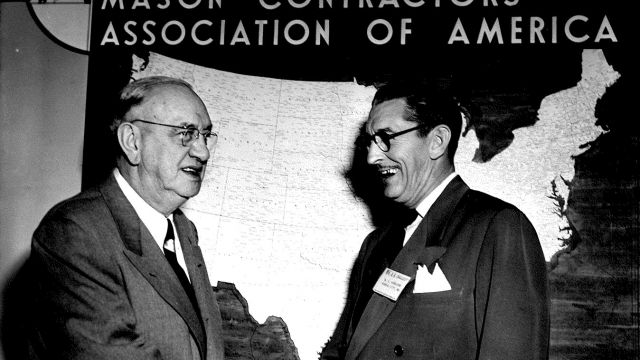A Brief History of the Mason Contractors Association of America
“Endeavor to develop and maintain within the masonry industry, a high appreciation of the objectives and responsibilities of the Mason Contractors of America.”- Abstract of the Code of Ethics
The very first Mason Contractor Association was founded in 1887 in Milwaukee, Wisconsin, as the Frontier Mason Contractors Association of Milwaukee. The name of this chapter eventually changed to the Mason Contractors Association of Milwaukee and still exists to this day as one of the longest continuously running corporations in the State of Wisconsin. This organization laid the foundation for the formal creation and establishment of the Mason Contractors Association of America (MCAA) in 1950.
The world is continuously changing, and the 1950s saw a rapid evolution of the MCAA’s development. After electing a Board, including inaugural president Marshall Harrison, the organization spent the greater part of 1951 planning their first-ever trade show. The MCAA Show officially opened with an official ribbon-cutting ceremony in 1952, which would continue on with great success over the next four decades.
The MCAA Show, both in 1952 and for many years to follow, served the masonry community by providing a platform for vendors to showcase innovative new products and equipment and their applications on the jobsite. The following year, the MCAA began producing their first printed publication— called “News & Trends,” the publication was warmly received by industry members, and would eventually become known as the MASONRY Magazine readers know, love, and read today.
By 1954, a mere four years after their inception, the association had already begun to grow out of the formation stage and was now tackling some of the serious issues facing the masonry industry. This year marked the formation of the Material Handling Committee, and it was through their efforts that the general term “packaging” received it’s official definitely, still used to this day. That same year, the association was invited to participate in projects with the National Joint Board for the Settlement of Jurisdictional Disputes in the Construction Industry as well as the American Standards Association, strong evidence that the MCAA was gaining stature and high regard within the masonry and construction industries.
By 1955, the foundation experienced a phenomenal boom in popularity as their ranks swelled from 9 chapters in 1952 to 48 chapters with 20 pending applications and more on the horizon. This upswing continued into 1956, where the aforementioned “News & Trends” had become so popular and demands additional ad space became more insistent that in March, the MCAA launched Mason Contractor News, a predecessor to the eventual MASONRY Magazine you’re reading today.
As 1957 gave way to 1958, when the first material handling demonstration took place during the annual MCAA Show, the MCAA then moved into 1959, where the question of “retained percentage” commanded a great deal of the association’s attention and efforts. After passing a non-binding resolution in 1956 that directly addressed this issue, in 1959, the MCAA again worked with industry members as well as the City of Chicago to offer assistance with contract dispute resolution.
Things heated up further in the 1960s. Following a successful MCAA Show in Cincinnati in 1960, which featured built masonry displays, a forty-page, four-color production of MASONRY Magazine was released in February 1961 to the enjoyment of the masonry and construction industries. As the mid-60s passed quickly, the association experienced continued growth and success, with highlights like the implementation of lecture circuits in 1956, which would grow to eventually become today’s webinars, as well a meeting at the St. Louis Convention in 1967 that would spark the creation of the Canadian Masonry Contractors Association- the first of its kind.
In 1969, the MCAA Show narrowly escaped disaster after the air freight company carrying the convention materials lost the shipment. With less than 18 hours before the expo began, the shipment was found at the original airport, ruined by rain, but that didn’t stop association members from conducting an All-Weather Demonstration that was a tremendous success.
The following decade started off with a bang and saw the creation of the International Masonry Institute in 1970, and their subsequent publication of “Recommended Practice’s for Cold Weather Masonry” later that year. The labor disputes affecting the construction industry were continuing to plague the nation came to a peak in the early ’70s, and as a result, President Nixon created the Construction Industry Stabilization Committee in March 1971.
MCAA member George Miller was selected to participate in the Committee, which worked until April 1974 to conduct research and implement changes that would improve unreasonable wage and contract demands by retarding wage settlements and reducing work stoppages. After a wonderful trip to Las Vegas (the first MCAA Show in a western state) that same year, it was time to celebrate the MCAA’s 25th Anniversary in 1975.
Having already achieved some much, the MCAA members still knew there was more work ahead, and that same year, OSHA passed highly restrictive rules regarding “overhand bricklaying,” which would potentially be a crippling blow to the masonry industry. In response, the MCAA conducted an industry survey, indicating few accidents occur as a result of this bricklaying practice. These results were then taken and presented to Eula Bingham, former Assistant Secretary of OSHA, USDL, who took them under advisement and review.
The subsequent years passed swiftly, and as the 1980s approached, it was clear the MCAA was now a real success in the masonry industry when, in 1981, Bingham ruled that due to the association’s efforts, “masons and mason tenders are exempt from these regulations.” This was a major victory for the MCAA and remains so to this day. However, the rest of the decade would see a lot of ups and downs.
After many years of continued growth, membership slumped from its peak of 1,400 members down to less than 800 in 1984, which followed the worst economic period that the MCAA had encountered since its inception in 1982-83. These were some difficult years. Leading into the early 90s, the association underwent some drastic changes, including an important amendment to its Constitution, which granted the Executive Board the power to negotiate and sign labor agreements and bind members to adhere to them.
This was controversial. After much discussion, the Amendment was repealed the following year. Structural changes like this one made the following years a little rocky, but things started to look more positive in 1988 when on June 16th, the MCAA and National Concrete Masonry Association announced a joint statement of purpose to establish a World of Masonry Expo, beginning in 1990.
A combination of the MCAA conference and show and the NCMA’s Concrete Industries Exposition and Convention, Masonry Expo ‘90 was a huge success, but grumblings of workforce development issues were a common conversation. This trend has unfortunately continued to this day and is a major focus of the MCAA. The 1990s saw a major transition to computers and advanced technological innovations, which greatly improved the efficiency and safety of career masonry and construction professionals and were heavily promoted by the MCAA through Computer Training Courses, which eventually gave way to the Webinars of recent years.
In the last two decades, the MCAA has continued to promote the interests of mason contractors and career masons while providing resources to further the development of masonry skills, as well as expanding their publishing presence. In 2018, MASONRY Publications acquired and launched MASONRY Design, which is focused on serving the architecture and design community with information and ideas about designing with brick, block, and natural stone. With grand plans for the future and a 70 year anniversary to celebrate this year, it seems there’s no stopping the MCAA.
About the Author



















